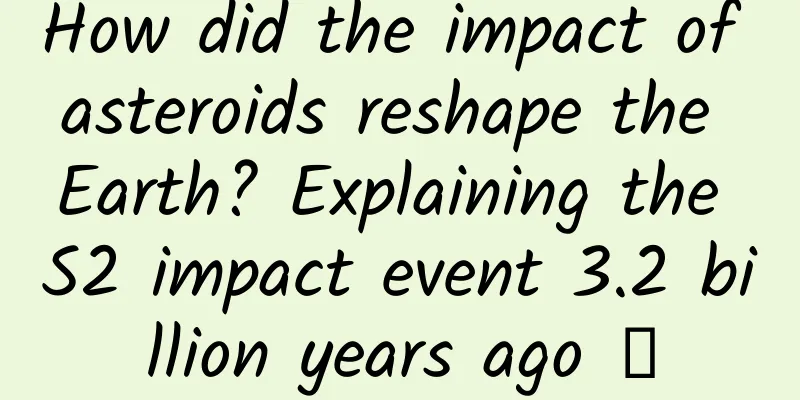How did the impact of asteroids reshape the Earth? Explaining the S2 impact event 3.2 billion years ago →

|
Tuchong Creative In its 4.6 billion years of history, the Earth has experienced countless celestial body impact events, which not only shaped the Earth's landforms, but also profoundly affected the Earth's environment and the origin and evolution of life. However, the number of impact craters on Earth is far less than that on the Moon, because the Earth's intense geological activity and erosion have erased most of the traces. At the same time, the Earth's atmosphere can burn and block small celestial bodies, causing them to be consumed before entering the Earth and unable to form impact craters on the surface. Currently, there are only more than 200 confirmed impact craters on Earth. If all impact craters were preserved, the Earth's surface would be covered with countless impact craters of varying sizes, just like the Moon. Among the more than 200 impact craters, the oldest and largest is the Vredefort crater in South Africa, which was formed 2.02 billion years ago and has a diameter of more than 300 kilometers. Obviously, this is not the earliest and largest impact event on Earth. Scientists have been looking for geological records of impacts on Earth in its earlier history, exploring the impacts of these impacts on the Earth's geological structure and ecological environment, and the possibility that they provided the "seeds" for life on Earth. Existing studies have shown that during the Archean Eon, between 3.6 billion and 3.2 billion years ago, the Earth suffered at least eight large-scale impacts, and these impacts left evidence in the rocks of the Barberton Greenstone Belt in South Africa. Scientists have ranked these eight impacts from S1 to S8. Recently, a research team from Harvard University conducted a detailed study of the S2 impact event 3.26 billion years ago. They further confirmed the impact event by studying rocks from the Barberton Makhonjwa Mountains in South Africa. The researchers found a large number of tiny meteorite impact particles in the rocks - small balls. These small balls were formed when large meteorites hit the Earth, melted the Earth's rocks, and then splashed and cooled rapidly. They formed characteristic spherical sedimentary layers in the rocks. It is estimated that the diameter of the S2 meteorite when it hit the Earth was between 37 and 58 kilometers. This estimate is based on the geological structure of the impact crater, the impact metamorphic characteristics of the rocks, and isotope analysis. The size of the impact body is directly related to the energy generated by the impact, the distribution of the ejecta, and the impact on the environment and organisms. So how powerful and destructive was this impact? The team of scientists believes that the scale and impact of the S2 impact event far exceeded the well-known Chicxulub impact event in the Gulf of Mexico that caused the extinction of the dinosaurs. The latter occurred 66 million years ago and was caused by a meteorite with a diameter of about 10 kilometers, forming an impact crater with a diameter of about 200 kilometers, leaving a deep mark in the geological record and inducing the fifth mass extinction. An impact several times the diameter of Chicxulub would obviously have a much greater impact, including: 1. Global tsunami: The S2 impact triggered the largest tsunami known in history, which swept across the globe, tearing up the seafloor and flooding coastlines. 2. Ocean boiling and evaporation: The heat generated by the impact caused the upper layer of the ocean to boil, and tens of meters of sea water evaporated. At the same time, it heated the atmosphere, causing the temperature to rise by 100 degrees Celsius. 3. Atmospheric dust cloud: The impact ejected large amounts of dust and debris into the atmosphere, forming thick dust clouds that blocked out sunlight, leading to the extinction of simple life that relied on photosynthesis on land and in shallow water. 4. Nutrient release: The impact released essential nutrients such as phosphorus on a global scale, known as a "fertilizer bomb." The meteorite itself released large amounts of phosphorus and iron, both of which feed any microorganisms that can metabolize them. The team believes that the S2 meteorite impact and other large impacts of the early Archean period appear to have had mixed effects on early marine life. Some life forms were positively affected, while others faced greater challenges. Tsunamis, ocean evaporation, and darkness had the most severe impacts on photosynthetic organisms in surface waters, but chemoautotrophs and hyperthermia in lower waters may have been less affected. Adverse environmental effects may have been short-lived, lasting no more than a few years to decades, after which the biosphere would have recovered rapidly. In the medium term, an influx of phosphorus and injection of Fe2+ into shallow waters may have triggered a short-lived biological boom, especially triggering the iron cycle of microorganisms. This may have brought short-lived benefits to life in the early history of the Earth. They believe that on a global scale, early life may have benefited from the influx of nutrients and electron donors, as well as the emergence of new environments, due to major impact events. That is, while the S2 impact had a catastrophic effect on life, the environmental changes that followed the impact also created conditions for life to flourish. The impact caused land erosion and stirred up iron in the deep ocean, allowing bacteria that use iron as a metabolite to thrive. The number of single-celled organisms that feed on phosphorus and iron increased dramatically, and these findings support the view that scientists increasingly believe that the continuous, violent impact events that brought the Earth to life provided opportunities for early life to flourish. It can be seen that celestial impact events are an important force in the history of the Earth. They not only shape the Earth's landforms, but also have a profound impact on the origin and evolution of life. Although these events may cause mass extinctions, they may also provide conditions for the birth and evolution of new life. With the continuous advancement of scientific research, our understanding of these impact events will be deeper, thereby better understanding the mysteries of Earth's history and the evolution of life. This article is a work supported by the Science Popularization China Creation Cultivation Program Author: Xiao Long Reviewer: Zhou Binghong, Researcher, National Space Science Center, Chinese Academy of Sciences Produced by: China Association for Science and Technology Department of Science Popularization Producer: China Science and Technology Press Co., Ltd., Beijing Zhongke Xinghe Culture Media Co., Ltd. |
<<: Committing crimes in 26 provinces, the second brother also staged a "storm"!
>>: Can eating only meat make you healthier? The pros and cons of the Paleo diet
Recommend
When will Qingdao express delivery resume in 2022? When will the blockade be lifted?
According to the latest news, from 0:00 to 24:00 o...
Methodology for practical operation of short video
As usual, I have summarized some practical experi...
Beichen Asia Market: Analysis of Beijing Automobile Market in June 2022
1. New car transaction situation In June, Beijing...
What does the stamp on the pork prove?
As a meat lover, I believe everyone must love por...
How to optimize e-commerce promotion costs if they are too high?
Information flow promotion often encounters vario...
Oat milk is several times more expensive than cow's milk. Is it oats or milk?
In the past two years, a "plant trend" ...
CES2015: Razer Forge TV Gaming Set-Top Box
Are you tired of the smartphones, watches and car...
IDC: AI-driven smartphone spending will reach $32 billion in 2028
IDC's 2025 Asia Pacific (excluding Japan) cus...
Analysis of advertising in the education and training industry from March to May
Due to the impact of delayed resumption of work, ...
Xiaomi will lose the patent war? Where does Ericsson get the confidence from?
"May 21st". This is probably one of the...
"Coal" speaks "wisdom": What kind of sparks will be created when coal miners encounter intelligence?
The 2024 China Guizhou International Energy Indus...
Taking Xiaomi and Hammer as examples, we can explain the two pricing logics of products
· There is a classic textbook in American marketi...
Domestic H5 development: Sunflower realizes H5 WeChat remote control and provides a new path for embedded development
Recently, the domestic remote control brand Sunfl...
Data analysis practice: If I do data analysis for shared bicycle products
Many people are asking: How to improve data analy...
A huge planet dominated by storms, the Great Red Spot can swallow the Earth, and Jupiter also has a dense core?
Jupiter, one of the eight planets in the solar sy...









